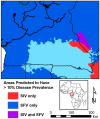Why Are Nigeria-Cameroon Chimpanzees (Pan troglodytes ellioti) Free of SIVcpz Infection?
- PMID: 27505066
- PMCID: PMC4978404
- DOI: 10.1371/journal.pone.0160788
Why Are Nigeria-Cameroon Chimpanzees (Pan troglodytes ellioti) Free of SIVcpz Infection?
Abstract
Simian immunodeficiency virus (SIV) naturally infects two subspecies of chimpanzee: Pan troglodytes troglodytes from Central Africa (SIVcpzPtt) and P. t. schweinfurtii from East Africa (SIVcpzPts), but is absent in P. t. verus from West Africa and appears to be absent in P. t. ellioti inhabiting Nigeria and western Cameroon. One explanation for this pattern is that P. t. troglodytes and P. t schweinfurthii may have acquired SIVcpz after their divergence from P. t. verus and P. t. ellioti. However, all of the subspecies, except P. t. verus, still occasionally exchange migrants making the absence of SIVcpz in P. t. ellioti puzzling. Sampling of P. t. ellioti has been minimal to date, particularly along the banks of the Sanaga River, where its range abuts that of P. t. troglodytes. This study had three objectives. First, we extended the sampling of SIVcpz across the range of chimpanzees north of the Sanaga River to address whether under-sampling might account for the absence of evidence for SIVcpz infection in P. t. ellioti. Second, we investigated how environmental variation is associated with the spread and prevalence of SIVcpz in the two chimpanzee subspecies inhabiting Cameroon since environmental variation has been shown to contribute to their divergence from one another. Finally, we compared the prevalence and distribution of SIVcpz with that of Simian Foamy Virus (SFV) to examine the role of ecology and behavior in shaping the distribution of diseases in wild host populations. The dataset includes previously published results on SIVcpz infection and SFVcpz as well as newly collected data, and represents over 1000 chimpanzee fecal samples from 41 locations across Cameroon. Results revealed that none of the 181 P. t. ellioti fecal samples collected across the range of P. t. ellioti tested positive for SIVcpz. In addition, species distribution models suggest that environmental variation contributes to differences in the distribution and prevalence of SIVcpz and SFVcpz. The ecological niches of these two viruses are largely non-overlapping, although stronger statistical support for this conclusion will require more sampling. Overall this study demonstrates that SIVcpz infection is absent or very rare in P. t. ellioti, despite multiple opportunities for transmission. The reasons for its absence remain unclear, but might be explained by one or more factors, including environmental variation, viral competition, and/or local adaptation-all of which should be explored in greater detail through continued surveillance of this region.
Conflict of interest statement
Figures






References
-
- Santiago ML, Rodenburg CM, Kamenya S, Bibollet-Ruche F, Gao F, Bailes E, et al. (2002) SIVcpz in wild chimpanzees. Science 295: 465 - PubMed
-
- Prince AM, Brotman B, Lee DH, Andrus L, Valinsky J, Marx P (2002) Lack of evidence for HIV type 1-related SIVcpz infection in captive and wild chimpanzees (Pan troglodytes verus) in West Africa. AIDS Res Hum Retroviruses 18: 657–660. - PubMed
-
- Van Heuverswyn F, Li Y, Bailes E, Neel C, Lafay B, Keele BF, et al. (2007) Genetic diversity and phylogeographic clustering of SIVcpzPtt in wild chimpanzees in Cameroon. Virology 368: 155–171. - PubMed
MeSH terms
LinkOut - more resources
Full Text Sources
Other Literature Sources

